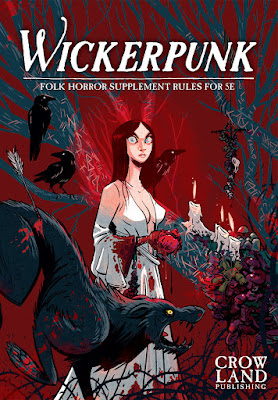As always I will be following my rules for these reviews.
PDF. 276 pages. Color cover. Black & White (as appropriate) interior art.
First things first. I love this name. I am kicking myself for not coming up with it first.
We get an introduction that, "Wickerpunk is where heroic fantasy and folk horror meet." Interesting premise.
Chapter 1: What is Wickerpunk
Here we learn how a "Wickerpunk" game differs from your normal heroic fantasy. It is not grim-dark, but it is dark. Nature is more dangerous, strange pagan gods still roam the land, and the locals still practice forgotten rites and ceremonies.
The author also lets us know that "wickerpunk" could be called "wyrdpunk" due to horror elements added to the game. This is not quite a gothic horror, but we can see that genre from here. The author is careful to let us know this is not horror and that horror-fiction and wickerpunk are cousins, not siblings. But kissing cousins to be sure.
Like my fascination with Pagans vs. Monotheists, this book covers the Wyld vs. Industry. The extension of this is Arcane vs. Divine magic. Where one is wrong and the other is a gift. My "old-faith vs. new-faith" is even covered later on.
There is a lot here, more than I will detail in this review, but suffice to say there is a lot of great ideas here on setting up your games.
Just under 25 pages I am now wanting to rip out the roots of my "War of the Witch Queens" campaign to add more of these ideas.
Chapter 2: Campaign Elements
This chapter details how a wickerpunk campaign affects your rules. up first is alignment. Law and Chaos are replaced by Industry and Wyld. Good and evil are replaced by Benevolence and Malice. Again...I want to use this instead of what I am using now.
Planes of existence have little use here since all that matters is the struggle of Industry and Wyld in the world of humans.
This chapter also covers various time periods from Stone Age to Victorian. And adventures from Mysteries, Treasure Seeking, and exploration among the eight presented.
There are some encounter tables which include types, places and motivations.
Chapter 3: Players and Characters
This chapter covers the 5e base classes and how they are altered in a wickerpunk game; both in terms of Wyld and Industry. These changes are not really mechanical, but rather thematic. They also include player hooks, example adventures, enemy hooks and NPC hooks. Throughout the book, inspirational reading or viewing is presented in a sidebar.
The same is done for the main PC species.
Chapter 4: Monsters
This chapter takes the types of monsters and discusses how they can be used in a wickerpunk game. There are more details on fey, fiends and undead as expected, but nearly every type of monster is considered. It is very flavorful. There is not much or anything in the way of "crunch" or game mechanics, but honestly, it is not needed here since the material is so good. It reminds me a bit of the old Ravenloft materials.
Chapter 5: Enemy Organisations
What is "The Wicker Man" without Lord Summerisle and his cult? Or "Children of the Corn" without the children? Not much really. This chapter covers the various organizations, or Cults and Cult Hunters. The PCs find themselves between the Wyld Cults (and Gods) and the Industry Inquisition.
Yes, this chapter also includes ideas for witches (even though 5e does not have a real witch class).
Chapter 6: Magic and Technology
The tools of the Wyld and Industry. There are some new ideas for magic items and spells, but only one spell is presented, "The Evil Eye."
Chapter 7: Sample Campaigns
There is a sample campaign here, the Island of Eye. Which looks a lot like England. Detailed here are what the humans and the older inhabitants of the land are doing. Plenty of locations and adventure hooks are detailed here. As well as plenty of interesting NPCs
Chapter 8: Appendix N
A nod to the famous Appendix N in the 1st Ed AD&D DMG. This covers various campaign periods. Each section includes movies, novels, television, comics, and video games. With commentary.
--
There is very, very little game-specific information here. If you are looking for mechanics or "crunch" then you are likely to be disappointed. But if you are looking for something more thematic or "fluff" then this is fantastic.
This is also this book's greatest unadvertised strength. It can be used with any version of D&D you like. While reading I kept thinking about how can I use this with say Old-School Essentials or even B/X D&D and the answer is "Easy." In fact one of the few actual bits of game material, the Evil Eye spell, is something I did years ago in my first witch book. But even then the conversion is super simple.
There are a lot of things I can use here for my War of the Witch Queens campaign, but I would also suspect that any D&D 5e DM could use these ideas for their Ravenloft or the Wild Beyond the Witchlight campaigns.
In any case, there is so much here to love.



Ever read "The Blessing of Pan" by Lord Dunsany? It's the resurgence of folk paganism in modern (ie, 1920s) England, but without horror; the main character is the local clergyman, who struggles against the paganism but finds himself alarmingly alone in the struggle. I think it's a great novel.
ReplyDeleteHuh. I am surprised at the cover artist, I would've sworn it was The Miko (Mihajlo Dimitrievski).
ReplyDeleteAlec Semicognito, I did, Many years ago. Yes, it is great.
ReplyDelete